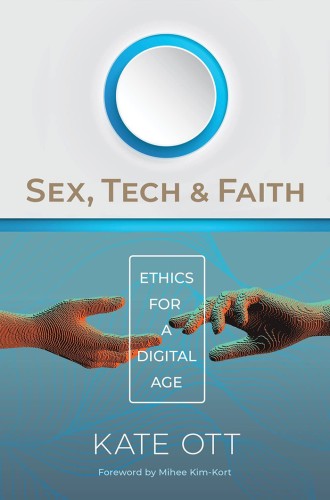A tech-savvy Christian sexual ethic
Kate Ott challenges us to practice erotically attuned love everywhere, even online.
If most young Americans receive any sex education at all, they hear flat messages to “just say no” or to wait until marriage. Few learn how to access birth control and fewer still how to properly use it. Many hear not a word about LGBTQ sexualities. Almost none are given resources to navigate the emerging realities of sex online. Yet we live in a thoroughly digital world, where sexting, digital pornography, online sexual abuse, and sex-focused AI have made unprecedented forms of sexual encounters and behaviors not only possible but common.
Despite admonitions to postpone sex until marriage, teens make extensive use of these sex technologies. Often in secret, without guidance or skills for self-protection, young people enter the land of digital sex as if entering a void. No wonder, then, that one in four young adults in the United States experience online sexual harassment or abuse by the time they are 18. Tragically, they are left to tread these waters alone.
Read our latest issue or browse back issues.
Kate Ott, who teaches Christian social ethics at Garrett-Evangelical Theological Seminary, offers patient and nonjudgmental counsel through this perilous and taboo terrain. Whether considering online dating platforms, cyberstalking, sexting, digital pornography, sex between online avatars, or sex robots, Ott’s discussion of each technology is precise and nuanced. Throughout the book’s main chapters, as well as in a very thoughtfully prepared youth study guide (complete with accompanying scripture texts, discussion questions, and group exercises), she sensitively helps readers build an ethical framework for considering whether and how these digital sex technologies might fit—or fail to fit—with the love commandment.
Ott recognizes the inescapable complexity of loving God and loving neighbor, and she is clear that digital technologies only make this call even more bewildering. Not shying away from the fact that people form attachment relationships to their phones and smart devices, or that lifelong exposure to these devices shapes how we perceive reality, she makes the case that these digital technologies are rapidly changing the nature of the task.
Nevertheless, she maintains that nurturing “a strong relationship between ourselves and God that includes our sexual selves in all their fullness” is an essential part of this command. In practice, this looks like “being empowered with knowledge about our sexuality; having the tools to communicate about sexual desire without embarrassment or shame; [and having] freedom to form relationships that sustain us emotionally, spiritually, and sexually.” Her thoroughly sex-positive and LGBTQ inclusive approach resists predominant cultural messages that Christians oppose and fear sex.
Instead, Ott favors a Christian sexual ethic that strives for “erotic attunement.” An ideal developed by the Catholic feminist ethicist Cristina Traina, erotic attunement centers “perceptive attention and adjustment to feelings, needs, and desires—both one’s own and others’.” Erotic attunement celebrates pleasure, acknowledging it as a God-created good, and asks partners to pay attention to the needs and pleasure of both self and other. To be erotically attuned, one must both be in touch with one’s own desire and be open to balancing that desire with another’s. A dynamic ideal, it neither prohibits certain sexual acts altogether nor provides unlimited license to act with indiscretion. By contrast, it requires reflection about the interpersonal impact of each act in a particular context.
This means that there can be no one-size-fits-all answer to how Christians should think about or use sex technologies. Rather than rules, Christians should identify the values that they want to guide their sexual and technological lives, and then ask how using certain technologies at particular times either does or does not resonate with those values. Values like respect for the self and others, reciprocal joy, and nonviolence stand out for Ott. This framework leads her to pose generous questions about the impact that each technology might have on those who use it instead of making judgments.
For example, she invites us to wonder, “Am I honoring my body or another’s or using it as an object when I view pornography or participate in sexting?” Ott’s discussion of pornography does not anticipate a simple “correct” answer. She considers the varied impact that pornography might have on a person based on their age, mindset, reasons for viewing (or making) it, and acquisition practices. Is it purchased from a company with ethical production practices? Is it viewed compulsively or freely with intention? Does it repeat racial or gender stereotypes and depict violence, or does it honor a variety of body types and illustrate consensual pleasure? That complexity invites us to consider our own unique position and context with respect to pornography usage and to draw on Ott’s framework to come to a considered conclusion about our own manners of use, or nonuse, of it.
Ott’s, then, is an invitation to put values into practice, even and especially in arenas that have largely been excluded from previous theological consideration. Her resistance to clear-cut answers, which easily stifle discussion and further reflection, creates space for real moral formation, hearty enough to bear complicated questions and maneuver through nuanced situations. In theological language, Ott issues a call to embodied discipleship. Unlike those who are quick to dismiss these technologies out of hand, she asks us to pause and consider how we would practice loving self, God, and neighbor while using online dating apps, sexting, or playing sex-focused games online. Sometimes simply asking the question is a radical act.
Her realism—which includes both the simple acknowledgment that Christians use these technologies (whether they are spoken about in church or not) and her dogged commitment to naming and grappling with often invisible violence (including online discrimination, harassment, and stalking)—makes the ethic that she develops in these pages not only relevant but also transformative. Time and again, she challenges us to practice erotically attuned love everywhere, even online. To practice love, whether by resisting the brewing violence in favor of cocreating a more loving digital world or by seeking pleasure online in more just, safe, and respectful ways.
Ott’s eminently readable book will be especially useful for youth group leaders, parents, teachers, and young adults who are navigating these questions in real time. The youth study guide is an excellent resource. But Ott’s work is not merely practical and pedagogical. She reminds ethicists and theologians that our work lives and moves through real bodies and in emerging and unfamiliar places, like virtual reality, phone screens, and the vast internet. Those who call themselves Christian ethicists would do well to heed her call to take the interactions that occur in these worlds very seriously. For there, too, we find God moving in new ways amid the familiar call to love our neighbors as ourselves.







